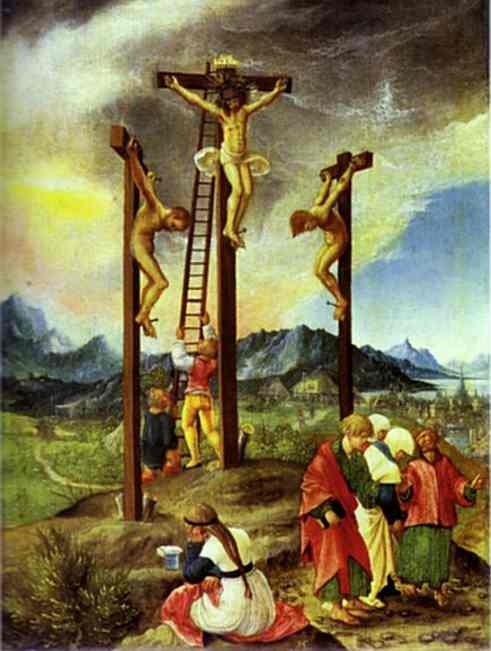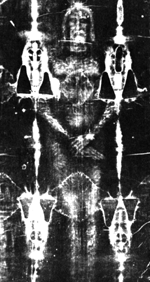|
Crucifixion Leave it to the human race to take something as wholesome as a tree and turn it into a device for torturous Execution.
Leave it to the human race to take something as wholesome as a tree and turn it into a device for torturous Execution. While the most famous crucifixion victim was Jesus Christ, he was hardly the only one. The practice dates back to at least 500 B.C., first coming into use in the Middle East. The earliest historical records of crucifixion are attributed to the Persians and Greeks, but the Romans really made it fashionable. Just in case you've been raised by wolves and somehow stumbled straight from the steppes to an Internet kiosk, we'd better start with a brief description of the process. Crucifixion is a method of execution in which the victim is nailed to a tree or a piece of wood with a cross beam. Religious iconography of crucifixion scenes often misrepresents some of the details. For one thing, victims were usually stripped naked. More significantly, the nails are driven through the wrists, not the hands, because the weight of the victim's body would shred the hands and allow the victim to fall off the cross maimed but not dead. Usually, the nails were reinforced by lengths of rope tying the arms to the cross. The feet were similarly pierced just below the ankles. While you might think that the pain and blood loss associated with this process would be the cause of death, that is not the case, a fact which will become important in some of the subsequent discussion. The cause of death in most crucifixions is actually suffocation. The victim has enough stability where the feet are nailed down to hold his body up (most victims were males). When the victim relaxes his legs and sags, the weight of his body drags the chest and shoulders down, hyperextending the arms and preventing him from breathing. Despite the hopelessness of his plight and the excruciating pain caused by every movement, the human body is hard-wired to draw breath by whatever means necessary, even when it doesn't make sense (which is why you can't kill yourself by holding your breath). Therefore, when the crucifixion victim sags and can't breathe, a virtually undeniable instinct causes them to straighten their legs in order to draw a breath. This causes excruciating pain. The process then repeats. Done properly, it can take days for a crucifixion victim to die. The Romans popularized (if that's the word) crucifixion by the time of Christ as a punishment for rebellious slaves, political criminals and really, really bad guys. Crucifixion was particularly effective in sending a message to seditious populations concerning the likely fate of those who fuck with authority. In Jerusalem around the time of Christ, the population was particularly seditious and the governor, Pontius Pilate, was a particularly bloodthirsty guy by many accounts. This resulted in a fair number of crucifixions, which took place on a very visible hill overlooking the city, Calvary. Victims were required to carry their crosses through the city to Calvary, just to make sure no one missed the point.
Of course, no one at the time could possibly have realized just what a big deal the crucifixion of Christ would eventually prove to be. Christians believe that Jesus was crucified on the Friday before Passover, then rose from the dead three days later. This concept forms the cornerstone of the entire religion in most of its various forms. Some early Christians, most notably the Gnostics believed the crucifixion of Christ was actually a gigantic fraud, an illusion perpetrated by Jesus who actually stood off to the side laughing while Simon of Cyrene died in his place. In recent years, more intricate theories have formed around the historical question of whether or not J.C. actually died on the cross. A variety of historical detectives have addressed the question in some detail. There are some interesting clues in the Bible on the subject. The New Testament states rather specifically that Christ's legs were not broken while he was on the cross. This is significant because the breaking of the legs would lead to rapid death, due to the aforementioned suffocation. The theories all boil down to something more or less like this: Jesus was crucified, most likely at the behest of his political/religious enemies. Enter the Essenes, an ancient sect of monks and healers once led by John the Baptist. (Some historical evidence suggests Jesus may also have been an Essene.)
These drugs helped keep Jesus alive and in more or less three days, he recovered from his injuries. The cloth picked up an imprint of his body and wounds (this has been recreated in a modern lab setting), due to the medicines used and his blood and bodily secretions, and the cloth was saved. Jesus and Mary Magdalene had a child. As the tale of Christ's miraculous resurrection spread, the secret of the child and the evidence of the cloth were closely guarded, , and Mary eventually emigrated to France with the kid. A society formed to protect these secrets. The secret of the bloodline and Christ's survival eventually became known as the Holy Grail (a process exhaustively detailed in the book "Holy Blood, Holy Grail"). The Knights Templar were eventually in charge of protecting the secrets, including the knowledge of Christ's descendents, who would later be a French royal lineage known as the Merovingian line, and the cloth, which became known as the Shroud of Turin. Regardless of the truth of any of the above, Christ certainly catapulted the concept of crucifixion into a leading icon in Western civilization. Artists endlessly depicted the event, and the icon of the cross became easily the most widespread symbol in an increasingly Christianized Europe. Subsequent to Christ's crucifixion, several of his followers were treated to the same style of execution. Most famously, Peter was crucified upside down. He asked for the reversal, explaining that he wasn't worthy of dying in the same was as his fearless leader. No doubt coincidentally, this is a much less painful way to be crucified, with unconsciousness and death coming in short hours instead of possibly days.
After the Middle Ages or so, the primary practice of crucifixion was mainly recreational or devotional. Vlad the Impaler was said to have been a fan of recreational crucifixion, although this may simply be a reference to his titular practice of impaling people on wooden stakes. In various parts of the world inhabited by overenthusiastic Catholics, such as the Philippines and Brazil, extremely devout and mentally unstable individuals occasionally choose to commemorate Christ's death by having themselves actually crucified, nails and all. This practice is frowned on by the church, for some strange reason, but that rarely deters those inclined to participate. As further evidence of the survivability of crucifixion, there aren't usually deaths associated with these spectacles. As historians can endlessly attest, stupidity is actually fatal much less often than you might think.
|
 Pilate's resistance to crucifying Christ in the gospels is somewhat baffling in light of his hardass reputation, but it's highly likely that his main motivation in "washing his hands" of the situation was inspired by the fact that the Jewish priests really wanted Christ crucified by the Romans, rather than executed by the Jews. Pilate's reluctance might have been politically motivated, or it might just have been a spiteful way to make life difficult for the Jews. He probably didn't anticipate that his effort to blame the Jews for Christ's death would contribute to rationalizations for the
Pilate's resistance to crucifying Christ in the gospels is somewhat baffling in light of his hardass reputation, but it's highly likely that his main motivation in "washing his hands" of the situation was inspired by the fact that the Jewish priests really wanted Christ crucified by the Romans, rather than executed by the Jews. Pilate's reluctance might have been politically motivated, or it might just have been a spiteful way to make life difficult for the Jews. He probably didn't anticipate that his effort to blame the Jews for Christ's death would contribute to rationalizations for the  Working together, the Essenes, Mary Magdalene and the Apostles paid the Romans to look the other way while they removed Jesus, still alive, from the cross. They took him to a quiet location (the tomb purchased by Joseph of Arimathea) and treated his wombs by wrapping him in a linen cloth soaked in the medicines of the day, such as aloe and myrrh.
Working together, the Essenes, Mary Magdalene and the Apostles paid the Romans to look the other way while they removed Jesus, still alive, from the cross. They took him to a quiet location (the tomb purchased by Joseph of Arimathea) and treated his wombs by wrapping him in a linen cloth soaked in the medicines of the day, such as aloe and myrrh. The Romans stopped using crucifixion as a form of execution when the Christians took over, although the practice remained in scattered usage around the world, especially in non-Christian domains.
The Romans stopped using crucifixion as a form of execution when the Christians took over, although the practice remained in scattered usage around the world, especially in non-Christian domains.